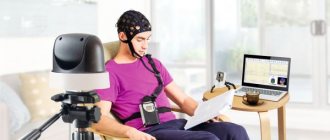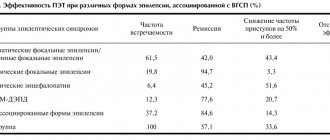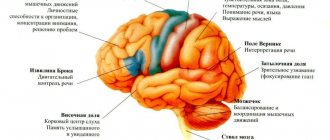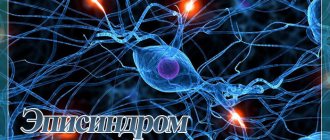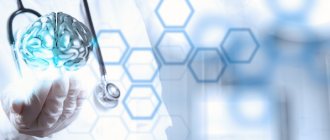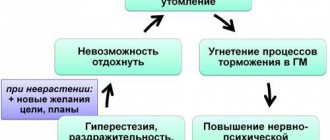Quite a large number of people are deeply mistaken when they believe that epilepsy cannot be cured.
In fact, epilepsy is not a death sentence and responds quite well to treatment until reaching the stage of remission and even complete recovery with the cessation of medications.
The most important thing is timely diagnosis and referral to highly qualified doctors, giving up bad habits (especially alcohol and cigarettes), timely taking all medications prescribed by the doctor and a correct lifestyle (for some forms of epilepsy, strict adherence to sleep/wake regime is required) .
It is noteworthy that an attack of epilepsy itself can manifest itself only once and go into a long stage of remission, and vice versa, latent epilepsy can become a constant companion throughout life.
Epilepsy: classification of seizures
Today, in modern world medicine, it is customary to distinguish two main groups of seizures caused by epilepsy. Typically, each of them is determined by the original source, which most often begins to be localized in areas of one or another part of the brain, thereby causing an epileptic discharge.
If an attack occurs in certain areas of the cerebral cortex, it is usually called either a partial or focal attack. After which, epileptic discharges spread not to individual areas of the cortex, but to almost the entire gray matter as a whole. Epileptic seizures can also be characterized by simultaneous discharge activity in both hemispheres of the cerebral cortex and are called a generalized seizure.
If the focus of the main activity is in the frontal and temporal lobes, or in rare cases in the occipital areas, it is usually called a focal epileptic seizure. Those types of seizures that doctors are unable to logically attribute to either of the two groups are called unclassifiable.
How can we help
The neuro-rehabilitation center employs qualified specialists who are ready to provide professional assistance to every child. Since epilepsy is often accompanied by delays in general development and cognitive impairment, we recommend that you undergo a comprehensive examination and rule out possible developmental problems.
We strive to ensure that every child, after completing a course of therapy, can develop fully, does not experience psychological problems, and can study in a regular school.
Our center provides all the conditions to make children and parents feel comfortable:
- homely atmosphere and warm welcome;
- individual approach to each patient;
- modern medical equipment for diagnosis and correction of neurological disorders;
- complete confidentiality;
- individual correction program.
Various generalized types of epileptic seizures include:
Generalized tonic-clonic seizures. Most often they appear when the discharge spreads throughout the cerebral cortex and can be manifested by the patient’s shrill cry + unnatural tongue bite, tension and twitching of the whole body, increased heart rate, increased blood pressure.
Absence seizures. They may first appear at a young age or early adolescence. Usually, at the time of an epileptic attack, the child’s gaze suddenly freezes and is fixed on one point, while his eyelids may twitch. Then, swallowing movements, throwing the head back may be more often observed, or, conversely, the patient drops his head; rarely there may be manifestations of a vegetative nature. The duration of these attacks is no more than 30-45 seconds.
Myoclonic seizures. They arise quite suddenly for the person himself, but have a very long duration. This attack externally manifests itself in involuntary muscle contraction, which often affects not only the head, arms and legs, but also the entire body.
Tonic seizures. They manifest themselves in the form of sharp, varying duration of tension in various muscle groups, mainly on both sides, and can be accompanied by a fall, including a sharp fall forward with injury.
Atonic (attacks of falls). Perhaps, they are still considered the rarest types of this disease and, accounting for only 1.5% of the total number of epileptic seizures, are diagnosed in the most complex forms of epilepsy.
Disease prognosis
The disease can have different forms and nature. Short-term seizures do not damage brain cells, unlike long-term seizures, which can cause the death of nerve cells in the brain. Sudden loss of consciousness has a negative impact on the child's health, which can lead to injuries and accidents.
As the disease develops, the child may experience psychological problems - he may begin to fear seizures, which may result in panic attacks.
Causes of epilepsy
According to experts, this disease has a fairly wide range of causes that can affect not only its occurrence, but also its further development. There are also individual cases when it is simply impossible to determine with exact certainty a certain cause-and-effect relationship between attacks.
Doctors consider the two main risk groups to be:
- predisposition to this diagnosis along a consanguineous line (i.e. genetic cause). This feature is already laid down in utero and encoded in genes, passed on from generation to generation;
- a predisposition that was acquired as a result of a number of specific damaging factors or pathological diseases of the cerebral cortex.
It has also been proven that the cause of epilepsy in both children and adult men and women can be:
- Traumatic brain injuries;
- Acute or chronic meningitis, encephalitis;
- Serious cerebral circulatory impairment (especially if direct hemorrhage has occurred);
- Volumetric processes in the brain (i.e. formation and rapid development of a tumor);
- Due to frequent and excessive use of drugs or alcohol;
- The presence of cysts, adhesions, aneurysms, etc. in the left, right, or both hemispheres of the brain at once
Almost all of the above risk factors, for the most part, one way or another lead to the emergence of a certain category of neurons with a low excitation threshold. It is this category of neuron cells that provides fertile ground for the emergence of an epileptic focus. Next, a nerve impulse is generated in it, which infects nearby cells, managing to reach new healthy neural networks. By the way, this is where convulsions or, in other words, epileptic seizures appear.
Complications
Epilepsy is dangerous because it can cause a number of serious complications and even lead to the death of the patient.
Complications:
- Neurogenic pulmonary edema - due to improper functioning of the central nervous system, arterial hypertension occurs, which increases the load on the left atrium. This leads to pulmonary edema.
- Aspiration pneumonia—during a seizure, foreign bodies or vomit may enter the airways.
- Status epilepticus is a series of frequently recurring seizures. Sometimes the patient does not regain consciousness between attacks. Epistatus can lead to coma.
- Mental disorders: depression, irritability, rigidity of thinking, pickiness, resentment, aggressiveness.
- Death during a seizure.
To avoid complications, you must strictly follow your doctor’s prescriptions and undergo examination.
The main symptoms of epilepsy in adults include:
Focal seizures . Most often, medical practice associates them with the occurrence of excess electrical discharge in one of the areas of the cerebral cortex. During these attacks, convulsions or sudden numbness or other sensations in the arms, legs, facial muscles, etc. are usually observed. Most often, the person remains conscious and clearly remembers his sensations. The duration of a focal attack lasts from 15-20 seconds to several minutes (rarely up to several tens of minutes).
Generalized seizures:
Convulsive. Often the first sign of epilepsy in an adult is tension in the muscles of the chest and larynx, a high-pitched cry, and even unnatural biting of the tongue. Within a few seconds, muscle tension occurs, followed by twitching and relaxation after 3-4 minutes (in this case, involuntary urinary incontinence or defecation can often occur). Next, a person may experience severe drowsiness, fuzzy and unclear consciousness, aching headache in the back of the head with rapid onset of sleep.
Non-convulsive (absence seizures). As mentioned above, these non-convulsive seizures occur more often in childhood or early adolescence. At the time of an epileptic attack, the child’s gaze suddenly freezes and is directed at one point, while his eyelids may twitch, his head may throw back, or slight nods forward are noted. The duration of these attacks is usually no more than 30 seconds.
Diagnostics
The attending physician begins making a diagnosis by collecting anamnesis and questioning the patient’s relatives. Need to know:
- when did the first seizure occur?
- personal feelings of the patient during an attack;
- whether seizures occur regularly;
- what were the muscle spasms?
The patient's relatives will tell you what the seizure looked like, and the doctor will be able to get an idea of the disease and even find out in which part of the brain the epilepsy focus is located.
After this, an electroencephalogram is performed, which will accurately determine the epiactivity, focus and all signs of the disease. An EEG taken during a seizure will provide additional information.
If a patient is at high risk of epilepsy and feels weakness in the legs and arms, headaches, and lack of coordination, he may undergo an MRI of the brain.
Once the diagnosis is made, the doctor prescribes medications that reduce the frequency of seizures. These medications must be taken for life and checked regularly. If the cause of the disease is injury or tumor, the patient undergoes surgery. In case of severe epilepsy, the patient may be assigned a disability group.
Epilepsy: first aid
In the event that you become an involuntary witness to an epileptic attack of your relative, good friend or just a stranger from the outside, you need to do the following:
Throw panic aside and come to your senses, because you must not forget that now the life of another person completely belongs to you and only you can help him. Call emergency services immediately.
While the attack lasts, be sure to stay close to the patient and under no circumstances leave him.
Take a look at everything that is around. Is there any threat around you? Once you are sure that everything is fine, do not touch the person, much less move him. It is best to eliminate nearby objects in the form of furniture, sharp or piercing objects that may accidentally cause harm or pain.
As a matter of urgency, turn on the timer or read the time out loud from the second the epileptic attack occurred.
If the person is standing, you should carefully lower his body to the ground and place any soft object (jacket, hat, empty backpack, etc.) under his head.
Under no circumstances should you try to forcibly restrain a person in a constrained state in order to supposedly prevent a convulsive state. This will not help relax the muscles, but it can cause serious injuries.
Do not open or put anything in the sick person's mouth. It would also be unnecessary to try to unclench his jaw during an attack.
The last thing is to check again whether the timer is set.
After everything is over, provide moral support and, if possible, calm the person down. Your speech should not be rude or sound like a quick set of phrases.
Provoking factors in children
Epilepsy is not considered a childhood disease, but is more often diagnosed at an early age. Depending on the form of the disease, it can manifest itself in different ways. Epilepsy is accompanied by convulsions and loss of consciousness.
The most common causes of epilepsy in children are:
- neck and head injuries during birth;
- hypoxia (oxygen starvation) of the fetus;
- infectious diseases suffered by the mother during pregnancy;
- maternal abuse of alcohol and drugs during pregnancy.
The disease can appear in a child immediately after birth or several years later. Minor convulsive movements in children under three months of age may be a consequence of an immature nervous system. However, if they are present, you should consult a neurologist to exclude pathology. If seizures continue to appear after three months of life, intensify and occur spontaneously, it is necessary to show the child to a pediatric neurologist.
Parents need to pay attention to the following symptoms in their child:
- fading;
- loss of concentration;
- no reaction to stimuli;
- high temperature;
- fainting;
- lethargy;
- headache;
- nausea;
- stomach ache;
- dizziness.
If these symptoms occur, call a doctor immediately or take your child to the hospital.
Treatment for epilepsy
If you believe the results of modern drug therapy, then it, like no other, is the main and main way to combat epilepsy. The effectiveness of drug therapy is up to 69%, which can significantly reduce the threshold for the occurrence of epileptic seizures, as well as their further spread.
In addition, in the twenty-first century, surgical techniques have also found widespread use (in the treatment of epilepsy). Of course, intervention through brain surgery is most often used only in cases where medications are no longer effective.
According to highly qualified neurologists and psychiatrists, several other methods of treating the disease have also proven successful, namely:
A diet called Ketogenic. Today, this is one method to reduce the number of epileptic seizures, but this diet is prescribed exclusively for severe forms of epilepsy in cases where medications are no longer effective.
Alternative methods of treating epilepsy also include stimulation of the vagus nerve, as well as multiple subpial transsection. The latter was created with the aim of controlling or eliminating an epileptic focus in the brain, which can no longer be safely removed. That is why the surgeon makes small incisions on the brain tissue without disturbing its normal activity at all.


